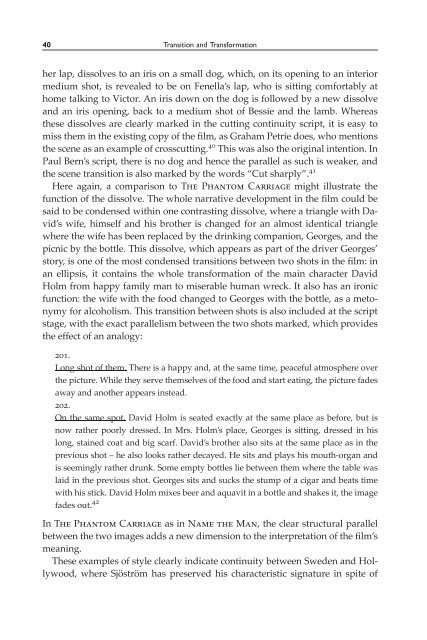FILM FILM - University of Macau Library
FILM FILM - University of Macau Library
FILM FILM - University of Macau Library
Create successful ePaper yourself
Turn your PDF publications into a flip-book with our unique Google optimized e-Paper software.
40 Transition and Transformation<br />
her lap, dissolves to an iris on a small dog, which, on its opening to an interior<br />
medium shot, is revealed to be on Fenella’s lap, who is sitting comfortably at<br />
home talking to Victor. An iris down on the dog is followed by a new dissolve<br />
and an iris opening, back to a medium shot <strong>of</strong> Bessie and the lamb. Whereas<br />
these dissolves are clearly marked in the cutting continuity script, it is easy to<br />
miss them in the existing copy <strong>of</strong> the film, as Graham Petrie does, who mentions<br />
the scene as an example <strong>of</strong> crosscutting. 40 This was also the original intention. In<br />
Paul Bern’s script, there is no dog and hence the parallel as such is weaker, and<br />
the scene transition is also marked by the words “Cut sharply”. 41<br />
Here again, a comparison to The Phantom Carriage might illustrate the<br />
function <strong>of</strong> the dissolve. The whole narrative development in the film could be<br />
said to be condensed within one contrasting dissolve, where a triangle with David’s<br />
wife, himself and his brother is changed for an almost identical triangle<br />
where the wife has been replaced by the drinking companion, Georges, and the<br />
picnic by the bottle. This dissolve, which appears as part <strong>of</strong> the driver Georges’<br />
story, is one <strong>of</strong> the most condensed transitions between two shots in the film: in<br />
an ellipsis, it contains the whole transformation <strong>of</strong> the main character David<br />
Holm from happy family man to miserable human wreck. It also has an ironic<br />
function: the wife with the food changed to Georges with the bottle, as a metonymy<br />
for alcoholism. This transition between shots is also included at the script<br />
stage, with the exact parallelism between the two shots marked, which provides<br />
the effect <strong>of</strong> an analogy:<br />
201.<br />
Long shot <strong>of</strong> them. There is a happy and, at the same time, peaceful atmosphere over<br />
the picture. While they serve themselves <strong>of</strong> the food and start eating, the picture fades<br />
away and another appears instead.<br />
202.<br />
On the same spot. David Holm is seated exactly at the same place as before, but is<br />
now rather poorly dressed. In Mrs. Holm’s place, Georges is sitting, dressed in his<br />
long, stained coat and big scarf. David’s brother also sits at the same place as in the<br />
previous shot – he also looks rather decayed. He sits and plays his mouth-organ and<br />
is seemingly rather drunk. Some empty bottles lie between them where the table was<br />
laid in the previous shot. Georges sits and sucks the stump <strong>of</strong> a cigar and beats time<br />
with his stick. David Holm mixes beer and aquavit in a bottle and shakes it, the image<br />
fades out. 42<br />
In The Phantom Carriage as in Name the Man, the clear structural parallel<br />
between the two images adds a new dimension to the interpretation <strong>of</strong> the film’s<br />
meaning.<br />
These examples <strong>of</strong> style clearly indicate continuity between Sweden and Hollywood,<br />
where Sjöström has preserved his characteristic signature in spite <strong>of</strong>

















